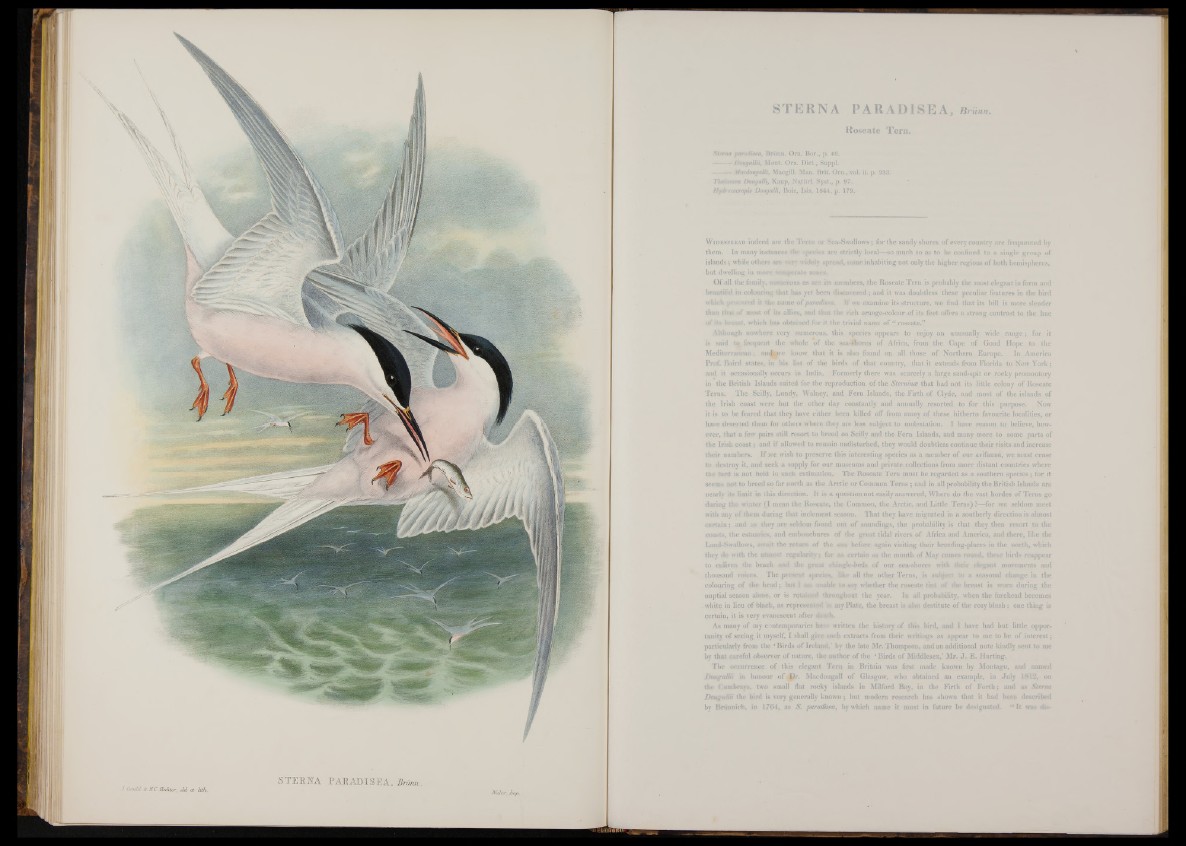
STERNA PARADISEA, Brunn.
Roseate Tern.
Sterna parttdieea, Brunn. Orn. Bor., p. 40.
----- Dmgallii, Mont. Orn. Diet., Suppl.
MacdougaUi, Macgill. Man. Brit. Orn., vol. ii. p. 233.
Thaamea Dougalli, Kaup, NatUrl. Syst., p. 97.
Nfdrocecropis Dougalli, Boie, Isis, 1844, p. 179.
W id e s p r e a d indeed are the Terns o r Sea-Swallows; for the sandy shores o f every country are frequented by
them. In many instauces the «eries are strictly local—so much so as to be confined to a single group of
islands; while others are wry widely spread, some inhabiting not only the higher regions of both hemispheres,
but dwelling in more temperate zones.
Of all the family, nawerous as are its members, the Roseate Tern is probably the most elegant in form, and
beautiful in colouring that has yet been discovered ; and it was doubtless these peculiar features in the bird
which procured it the name o f paradisea. If we examine its structure, we find that its hill is more slender
than thui most o f its allies, and that the rich orange-colour o f its feet offers a strong contrast to the hue
of its breast, which has obtained for if; the trivial name o f “ roseate.”
Although nowhen i very numerous, this species appears to enjoy an unusually wide range; for. it
» said to frequent the whole o f the sea-lhores of Africa, from the Cape o f Good Hope to the
Mediterranean , ant^ve know that it is also found on all those o f Northern Europe. In America
Prof. Baird states, in his list of the birds o f that country, that it extends from Florida to New York;
and it occasionally occurs in India. Formerly there was scarcely a large sand-spit or rocky promontory
in the British Islands suited for the reproduction o f the Sterninee that had not its little colony o f Roseate
Terns. The Scilly, Lundy, Walney, and Fern Islands, the Firth o f Clyde, and most o f the islands of
the Irish coast were but the other day constantly and annually resorted to for this purpose. Now
it is to be feared that they have either been killed off from many of these hitherto favourite localities, or
have deserted them for others where they are less subject to molestation. I have reason to believe, however,
that a few pairs still resort to breed on Scilly and the Fern Islands, and many more to some parts of
the Irish coast; and if allowed to remain undisturbed, they would doubtless continue their visits and increase
their numbers. If we wish to preserve this interesting species as a member o f our avifauna, we must cease
to destroy it, and seek a supply for our museums and private-collections from more distant countries where
the bird is not held in such estimation. The Roseate Tern must be regarded as a southern species; for it
seems not to breed so far north as the Arctic or Common Terns ; and in all probability the British Islands are
nearly it* limit in this direction. It is a question not easily answered, Where do the vast hordes o f Terns go
during the winter (I mean the Roseate, the Common, the Arctic, and Little Terns) ?—for we seldom meet
with any o f them during that inclement season. That they have migrated in a southerly direction is almost
certain; and as they are seldom fonnd out o f soundings, the probability is that they then resort to the
coasts, the estuaries, and embouchures of the great tidal' rivers of Africa and America, and there, like the
L a n d -Swallows, await the return o f the sun before again visiting their breeding-places in the north, which
they do with the utmost regularity; for as certain as the month of May comes round, these birds reappear
to enliven the beach «iwi the great shingle-beds o f our sea-shores with their elegant movements and
thousand voices. The present species, like all the other Terns, is io a seasonal change in the
colouring o f the head; hut i unable to say whether the roseate tint o f the breast is worn during the
nuptial season alone, or is retained throughout the year. In all probability, when the forehead becomes
white in lieu of black, as represented in my Plate, the breast is also destitute o f the rosy blush: one thing is
certain, it is very evanescent after
As many of my contemporaries hav*- written the history o f this bird, and I have had but little opportunity
o f seeing it myself, I shall give anch extracts from their writings as appear to me to be o f interest;
particularly from the ‘ Birds of Ireland.,’ by the late Mr. Thompson, and an additional note kindly sent to me
by that careful observer o f nature, the author o f the ‘ Birds o f Middlesex,’ Mr. J . E. Harting.
The occurrence o f this elegant Tern in Britain was first made known by Montagu, and named
Dougallii in honour o f Dr. Macdougall o f Glasgow, who obtained an example, in July 1812, on
the Cumhrays, two small flat rocky islands in Milford Bav, in the Firth o f Forth; and as Sterna
DougaUii the bird is very generally known; but modern research has shown that it had been described
by Brunnich, in 1764, as S . paradisea, by which name it must in future be designated. “ It was dis